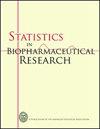肿瘤学IIA期临床试验改进Simon的两阶段设计——动态监测和更灵活
IF 1.5
4区 医学
Q3 MATHEMATICAL & COMPUTATIONAL BIOLOGY
引用次数: 0
摘要
本文章由计算机程序翻译,如有差异,请以英文原文为准。
Modified Simon’s Two-Stage Design for Phase IIA Clinical Trials in Oncology – Dynamic Monitoring and More Flexibility
Abstract The traditional Simon’s two-stage design for phase IIA clinical trials is modified to enhance the flexibility in conducting the interim analysis and sample size adjustment. The modification is based on the well-established methodology in adaptive designs using the conditional probability and allows for early termination as well as extension with sample size adjustment. The dynamic data monitoring system is naturally suitable for basket trials where several tumor types are monitored simultaneously with different enrollment rates.
求助全文
通过发布文献求助,成功后即可免费获取论文全文。
去求助
来源期刊

Statistics in Biopharmaceutical Research
MATHEMATICAL & COMPUTATIONAL BIOLOGY-STATISTICS & PROBABILITY
CiteScore
3.90
自引率
16.70%
发文量
56
期刊介绍:
Statistics in Biopharmaceutical Research ( SBR), publishes articles that focus on the needs of researchers and applied statisticians in biopharmaceutical industries; academic biostatisticians from schools of medicine, veterinary medicine, public health, and pharmacy; statisticians and quantitative analysts working in regulatory agencies (e.g., U.S. Food and Drug Administration and its counterpart in other countries); statisticians with an interest in adopting methodology presented in this journal to their own fields; and nonstatisticians with an interest in applying statistical methods to biopharmaceutical problems.
Statistics in Biopharmaceutical Research accepts papers that discuss appropriate statistical methodology and information regarding the use of statistics in all phases of research, development, and practice in the pharmaceutical, biopharmaceutical, device, and diagnostics industries. Articles should focus on the development of novel statistical methods, novel applications of current methods, or the innovative application of statistical principles that can be used by statistical practitioners in these disciplines. Areas of application may include statistical methods for drug discovery, including papers that address issues of multiplicity, sequential trials, adaptive designs, etc.; preclinical and clinical studies; genomics and proteomics; bioassay; biomarkers and surrogate markers; models and analyses of drug history, including pharmacoeconomics, product life cycle, detection of adverse events in clinical studies, and postmarketing risk assessment; regulatory guidelines, including issues of standardization of terminology (e.g., CDISC), tolerance and specification limits related to pharmaceutical practice, and novel methods of drug approval; and detection of adverse events in clinical and toxicological studies. Tutorial articles also are welcome. Articles should include demonstrable evidence of the usefulness of this methodology (presumably by means of an application).
The Editorial Board of SBR intends to ensure that the journal continually provides important, useful, and timely information. To accomplish this, the board strives to attract outstanding articles by seeing that each submission receives a careful, thorough, and prompt review.
Authors can choose to publish gold open access in this journal.
 求助内容:
求助内容: 应助结果提醒方式:
应助结果提醒方式:


